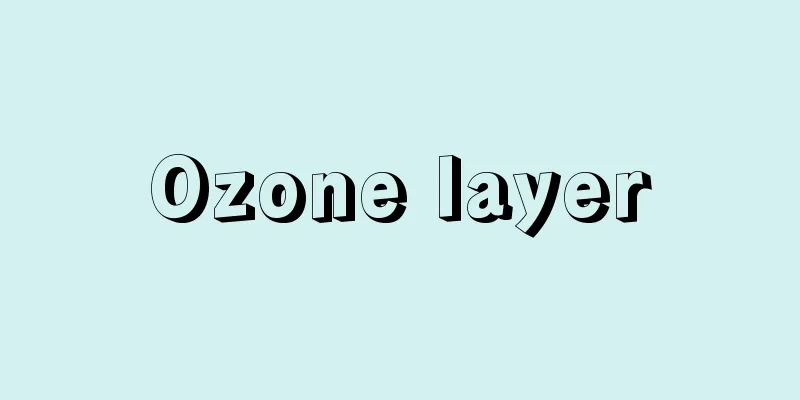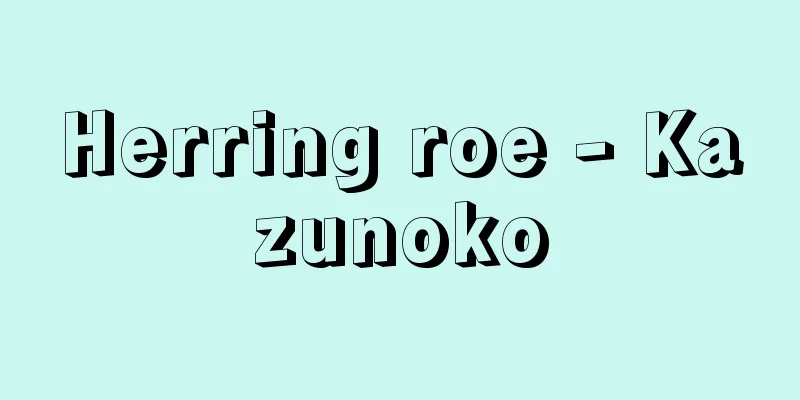Ozone layer

|
The area of high ozone concentration in the upper atmosphere. It begins at an altitude of 10 to 15 km above ground level and has the highest number density (partial pressure) at 20 to 25 km above ground level. Above that altitude, the density decreases gradually with height, continuing up to an altitude of 50 km. The density and vertical distribution of the ozone layer vary regularly with latitude and season. [Toshihiro Ogawa] The role of the ozone layerThe ozone layer is essential for the survival of terrestrial organisms. It absorbs the ultraviolet rays (also called ultraviolet light) from the sun that fall on the earth in the sky, protecting terrestrial organisms from being exposed to harmful ultraviolet rays. Short-wavelength ultraviolet rays with wavelengths of 310 nanometers or less destroy the nucleic acids in biological cells, but the ozone layer's ultraviolet absorption effect is effective against this ultraviolet light. However, near the absorption edge of 310 nanometers, the effect is not perfect, and some of the ultraviolet rays fall on the ground and cause damage to organisms. Organisms have various defense mechanisms against this. The effects of ultraviolet rays on the human body are known to have both benefits and losses. These include the induction of skin cancer and the production of vitamin D under the skin. The amount of solar ultraviolet rays that leak onto the earth changes sensitively depending on the amount of ozone in the sky. Therefore, the ozone layer is an important environmental factor that determines the amount of ultraviolet radiation on the ground. [Toshihiro Ogawa] Formation and evolution of the ozone layerOzone is a molecule consisting of three oxygen atoms. In the atmosphere, oxygen molecules are broken down into atomic oxygen by the action of ultraviolet light or discharge, and these oxygen atoms then combine with other oxygen molecules to become ozone. In the ozone layer, short-wavelength solar ultraviolet light with a wavelength of 240 nanometers or less plays a role in breaking down oxygen molecules. The ozone layer is unique to atmospheres that contain a large amount of oxygen, such as the Earth's atmosphere, and does not exist on other planets. Since oxygen in the Earth's atmosphere is produced by photosynthesis, the ozone layer can be said to be a barrier against solar ultraviolet rays that living things themselves have produced. In the early stages of Earth's history, the amount of oxygen was small, the ozone layer was weak, and the Earth's surface was exposed to harmful ultraviolet rays. On the other hand, underwater was protected from ultraviolet rays, so life arose there, and as photosynthesis became more active, the amount of oxygen in the atmosphere increased, and the ozone layer in the sky gradually developed. Then, as the ozone layer's protection against ultraviolet rays began to function effectively, land became an environment suitable for survival, and life activities moved to land and made great progress. In this way, it is believed that there was a close interrelationship between the development of the ozone layer and life activities. To what extent does the amount of oxygen in the atmosphere need to increase before the ozone layer's protection against ultraviolet rays becomes effective and terrestrial life can survive? According to theoretical calculations, the presence of about one-hundredth of the current amount of oxygen in the atmosphere is sufficient to create the necessary ozone layer. It would be appropriate to assume that such conditions were realized around the middle of the Paleozoic era, when land plants appeared. [Toshihiro Ogawa] The role of the ozone layer in weatherThe ozone layer is also important in terms of atmospheric structure and meteorology. The energy of solar ultraviolet rays absorbed by ozone heats the upper atmosphere, creating a temperature inversion structure. In other words, the formation of the stratosphere is mainly due to the heating effect of ozone. Since the atmospheric heating effect of ozone varies depending on latitude, a large-scale circulation of the atmosphere also occurs in the stratosphere to eliminate this difference. This large-scale circulation is integrated with that of the lower troposphere, and ozone is transported from low latitudes to high latitudes. As a result, the density of ozone is higher at high latitudes than at low latitudes directly beneath the sun, where ozone production is most active. In addition, ozone transport in the stratosphere is most active in spring, so the amount of ozone is high in spring and low in autumn when viewed seasonally. The general circulation of the atmosphere is one of the factors that determine the climate, and since ozone and the general circulation of the atmosphere mutually affect each other, the ozone layer is important as a climate determining factor. Ozone also strongly absorbs and emits infrared thermal radiation, which affects the thermal radiation of the atmosphere and in this respect also acts as a climate determining factor. [Toshihiro Ogawa] Ozone disappearance reactionOzone is quickly broken down by visible and ultraviolet light from the sun. However, the oxygen atoms produced in this process immediately regenerate ozone, so there is no net loss of ozone during this process. The reaction that leads to the loss of ozone is the reaction between oxygen atoms and ozone, which is relatively slow. In addition, ozone is destroyed by reactions with nitrogen oxides, hydrogen oxides, chlorine oxides, bromine oxides, etc. Although these oxides are gaseous components that exist in trace amounts compared to ozone, they can be efficiently destroyed by catalytic reaction cycles. The amount of ozone produced by the action of solar ultraviolet light is ultimately balanced with the amount of ozone lost in this way, resulting in the formation of a stable ozone layer. [Toshihiro Ogawa] Pollutants and the ozone layerThe possibility that various polluting gases could disrupt the balance of the ozone layer has been an issue since the 1970s. First, attention was focused on substances that are directly introduced into the stratosphere, such as nitrogen oxides in the exhaust of supersonic aircraft (SSTs) flying in the stratosphere, or nitrogen oxides produced during high-altitude nuclear explosions. Then, substances released on the ground diffuse into the stratosphere and turn into chlorine oxides and bromine oxides, such as chlorofluorocarbons (CFCs, commonly known as freon) used in sprays and freezers, carbon tetrachloride (tetrachloromethane) and halons used as fire extinguishing agents, and 1,1,1-trichloroethane used in cleaning, became a problem. If these polluting gases increase, they have the effect of lowering the balance concentration of ozone. Therefore, if the pollution state continues for a long time, the amount of ozone will decrease and the amount of ultraviolet radiation on the ground will increase. As a result, there will be an increase in the incidence of skin cancer, a decrease in crop yields, and adverse effects on the ecosystem. There is also concern about impacts on the climate. Ozone in the stratosphere diffuses into the lower troposphere in the wake of large-scale atmospheric disturbances, supplying ozone. There are frequent cases in which an air mass with high ozone density descends from the stratosphere into the troposphere, temporarily increasing the ozone density in the troposphere. This effect can also extend to the vicinity of the earth's surface, and it is thought that this is the reason why high oxidant concentrations sometimes appear in areas far from large cities. [Toshihiro Ogawa] Protection of the ozone layerIn the 1980s, an ozone hole was discovered over Antarctica, and it was revealed that its cause was the ozone depletion caused by chlorine oxides and bromine oxides, and the special weather conditions in the Antarctic region. In 1985, the Vienna Convention was adopted internationally to protect the ozone layer. In 1987, the Montreal Protocol was adopted to regulate ozone-depleting substances such as fluorocarbons. After several amendments and adjustments, the production of fluorocarbons and other substances is completely banned in developed countries, and will be completely banned in developing countries by the end of 2009, except for 1,1,1-trichloroethane. In addition, hydrochlorofluorocarbons (HCFCs), which are used as substitutes for fluorocarbons, and methyl bromide (bromomethane), which is used for fumigation, are scheduled to be completely phased out. As a result of these international regulatory measures, the total amount of chlorine and bromine in the atmosphere has remained stable as of 2002. However, due to the long-term trend of global decline in the ozone layer and the fact that the ozone hole over Antarctica has yet to recover from its original state, it will be necessary to continue monitoring polluting gases and changes in the ozone layer. [Toshihiro Ogawa] "Protecting the Ozone Layer, edited by the Environment Agency Ozone Layer Protection Review Committee (1989, NHK Publishing)" ▽ "The Ozone Layer Has Disappeared, by John Gribbin, translated by Kato Kei (1989, Chijin Shokan)" ▽ "Stratospheric Ozone, 2nd Edition, by Shimazaki Tatsuo (1989, University of Tokyo Press)" ▽ "Ozone Disappearance, by Kabira Koji and Makino Yukio (1989, Yomiuri Shimbun)" ▽ "Stratospheric Ozone, Guardian of the Earth - Why Does it Decrease? What Happens When It Decreases, by Shimazaki Tatsuo" (1989, Kodansha) ▽ Yasunobu Iwasaka, Ozone Hole: The Earth's Atmospheric Environment as Seen from Antarctica (1990, Shokabo) ▽ Toshihiro Ogawa, Physical Chemistry of the Atmosphere: An Introduction to New Atmospheric Environmental Science (1991, Tokyodo Publishing) ▽ Ministry of International Trade and Industry, Basic Industries Bureau, edited, Amended Ozone Layer Protection Act (1991, Gyosei) ▽ Ministry of International Trade and Industry, Basic Industries Bureau, Ozone Layer Protection Measures Office, Ozone Layer Protection Handbook (1994, Chemical Daily) ▽ Environment Agency, Global Environment Department, Ozone Layer Depletion: Health Effects of Ultraviolet Rays, Effects on Plants and Ecosystems (1995, Chuohoki Publishing) ▽ Hidetoshi Sugimitsu, Fundamentals and Applications of Ozone (1996, Korin) ▽ "When will the Antarctic ozone hole disappear? - Ozone layer protection and the Montreal Protocol" by Matsumoto Yasuko (1997, Jikkyo Publishing) " "Global warming and ozone layer depletion" by Izumi Kunihiko (1997, Shinnihon Shuppansha) " "Environmental diplomacy: The birth and development of the Treaty on the Protection of the Ozone Layer" by Richard E. Benedick, translated by Odagiri Chikara (1999, Industrial Research Association)" "Stratospheric ozone protects living things" by Sekiguchi Michio (2001, Seizando Shoten) [References] | | | | | |Source: Shogakukan Encyclopedia Nipponica About Encyclopedia Nipponica Information | Legend |
|
上空大気中にあるオゾン量の多い領域。地上高度10ないし15キロメートルより始まり、20~25キロメートルでもっとも数密度(分圧)が高くなる。それ以上の高度では、高さとともに緩やかに密度が減り、高度50キロメートルまで続く。オゾン層の密度や高度分布は、緯度と季節により規則的に変化する。 [小川利紘] オゾン層の役割オゾン層は地上生物の生存にとって欠かすことのできない存在である。地球に降り注ぐ太陽の紫外線(紫外光ともいう)を上空で吸収し、地上生物が有害な紫外線を浴びないよう保護しているからである。波長310ナノメートル以下の短波長紫外線は生物細胞の核酸を破壊するが、この紫外線に対して、オゾン層の紫外線吸収効果が有効に働く。しかし、吸収端の波長310ナノメートル付近では、その効果は完璧(かんぺき)ではなく、紫外線は一部地上に降り注ぎ、生物に損害を与える。これに対し生物は種々の防御機能を備えている。この紫外線の人体に及ぼす影響には、損益両面が知られている。皮膚癌(がん)の誘発と皮下でのビタミンD生成がそれである。地球上に漏れ込む太陽紫外線の量は、上空のオゾン量の多少によって敏感に変化する。したがって、オゾン層は地上の紫外線照射量を左右する環境因子として重要である。 [小川利紘] オゾン層の生成と発達オゾンは酸素原子3個からなる分子である。大気中で紫外線や放電などの作用により酸素分子が原子状の酸素に壊され、この酸素原子が酸素分子と結合してオゾンになる。オゾン層では、波長240ナノメートル以下の短波長太陽紫外光が、酸素分子を壊す役割をしている。オゾン層は地球大気のように酸素を多量に含む大気に特有のもので、他の惑星には存在しない。 地球大気の酸素は生物の光合成作用によってつくられたものであるから、オゾン層は生物自身がつくりだした太陽紫外線への防壁といえる。地球の歴史において、初期段階では酸素の量は少なく、オゾン層は貧弱で、地表は有害な紫外線にさらされていた。一方水中は紫外線から保護されていたので、そこで生命が発生し、光合成が活発になるにつれて大気中の酸素が増え、しだいに上空のオゾン層が発達した。そして紫外線に対する防止効果が有効に働き出すようになると、陸上が生存に適した環境となり、生命活動の舞台は陸に移り大きな発展を遂げることになった。このようにオゾン層の発達と生命活動との間には、密接な相互関係があったと考えられている。大気中の酸素量がどの程度にまで増えれば、オゾン層の紫外線防止効果が有効になり、陸上生物の生存が許されるようになるのだろうか。理論計算によると、必要なオゾン層をつくるには、現在量の100分の1程度の酸素が大気中に存在すれば十分であるという。このような条件が実現した時期としては、陸上植物が出現した古生代中ごろとするのが妥当であろう。 [小川利紘] オゾン層の気象における役割オゾン層は大気構造あるいは気象学上からも重要な存在である。オゾンの吸収する太陽紫外線のエネルギーは、上空大気を加熱して、気温の逆転構造をつくりだす。すなわち成層圏の形成はもっぱらオゾンの加熱効果によるものである。オゾンの大気加熱効果は緯度による差異があるので、この差を解消すべく成層圏大気においても大気の大規模な循環運動がおこる。この大規模循環は下層の対流圏のそれと一体となっており、これによってオゾンは低緯度から高緯度に運ばれる。そのため、オゾン生成のもっとも盛んな太陽直下の低緯度上空よりも、高緯度上空のほうが高密度となる。また成層圏におけるオゾン輸送は春にもっとも活発となるため、季節でみるとオゾン量は春に多く、秋に少ない。大気の大循環は気候を決定する要因の一つであるが、オゾンが大気大循環と互いに影響しあっていることから、オゾン層は気候決定因子として重要である。またオゾンは赤外熱放射を強く吸収、放出するので、大気の熱放射にも影響を与え、この点においても気候決定因子として働く。 [小川利紘] オゾンの消失反応オゾンは太陽可視光と紫外線によって速やかに分解される。しかし、この際生じた酸素原子はただちにオゾンを再生するので、この過程では正味のオゾン消失はおこらない。オゾンの消失につながる反応は、酸素原子とオゾンとの反応であるが、これは比較的遅い。これに加えて、窒素酸化物、水素酸化物、塩素酸化物、臭素酸化物などとの反応がオゾンを壊す。これらの酸化物はオゾンに比べ微量な気体成分であるが、触媒反応サイクルによって、効率よくオゾンを壊すことができる。太陽紫外線の作用によってつくられたオゾンの生成量は、このようにして消失するオゾンの量と最終的にはつり合いを保っており、その結果、安定したオゾン層が形成されている。 [小川利紘] 汚染気体とオゾン層種々の汚染気体によってオゾン層のつり合いが乱される可能性が1970年代から問題となった。成層圏を飛行する超音速航空機(SST)の排気中の窒素酸化物、あるいは高空核爆発の際生じる窒素酸化物のように直接成層圏に投入される物質がまず注目された。ついでスプレーや冷凍機などに使われるクロロフルオロカーボン類(CFC、通称フロン)、消火剤として使われる四塩化炭素(テトラクロロメタン)およびハロン、洗浄に使われる1・1・1‐トリクロロエタンなどのように、地上で放出された物質が成層圏に拡散し、塩素酸化物・臭素酸化物に変わる場合が問題とされた。これらの汚染気体が増えると、オゾンのつり合い濃度を下げる作用がある。したがって汚染状態が長期的に続くと、オゾン量が減少し、地上の紫外線照射量が増える。その結果、皮膚癌発生率の増加、作物の収量減、生態系への悪影響などが現れる。また気候への影響も考えられる。 成層圏のオゾンは、大気の大規模な乱れに伴って下層の対流圏に拡散し、オゾンを供給している。オゾン密度の高い気塊が成層圏から対流圏に降下して、一時的に対流圏のオゾン密度を高める事例がしばしばおこる。この影響は地表付近にも及ぶことがあり、大都市から遠く離れた地域で、ときおり高いオキシダント濃度が出現するのは、この影響によるものと考えられる。 [小川利紘] オゾン層の保護1980年代になって南極大陸上空にオゾンホールが発見され、その原因が、塩素酸化物・臭素酸化物によるオゾン破壊作用と南極域の特殊な気象条件であることが明らかになり、1985年には国際的にオゾン層を保護するためのウィーン条約が採択された。1987年には、フロン等のオゾン層破壊物質を国際的に規制するモントリオール議定書が採択され、その後数回の改正・調整を経て、フロン等の生産は、先進国では全面禁止、開発途上国でも1・1・1‐トリクロロエタンを除き2009年末で全面禁止となる。またフロンの代替品として使われているハイドロクロロフルオロカーボン類(HCFC)と燻蒸(くんじょう)に使われる臭化メチル(ブロモメタン)も全面的に廃止される予定である。こうした国際規制措置によって、大気中の塩素・臭素総量は2002年現在横ばい状態になっている。しかし、全地球的なオゾン層の長期減少傾向および南極大陸上空のオゾンホールの原状回復はこれからであり、汚染気体とオゾン層の変化は今後も監視を続けていく必要がある。 [小川利紘] 『環境庁オゾン層保護検討会編『オゾン層を守る』(1989・日本放送出版協会)』▽『ジョン・グリビン著、加藤珪訳『オゾン層が消えた』(1989・地人書館)』▽『島崎達夫著『成層圏オゾン』第2版(1989・東京大学出版会)』▽『川平浩二・牧野行雄著『オゾン消失』(1989・読売新聞社)』▽『島崎達夫著『地球の守護神 成層圏オゾン――なぜ減る? 減るとどうなる?』(1989・講談社)』▽『岩坂泰信著『オゾンホール――南極から眺めた地球の大気環境』(1990・裳華房)』▽『小川利紘著『大気の物理化学――新しい大気環境科学入門』(1991・東京堂出版)』▽『通商産業省基礎産業局編『改正オゾン層保護法』(1991・ぎょうせい)』▽『通商産業省基礎産業局オゾン層保護対策室監修『オゾン層保護ハンドブック』(1994・化学工業日報社)』▽『環境庁地球環境部監修『オゾン層破壊――紫外線による健康影響、植物・生態系への影響』(1995・中央法規出版)』▽『杉光英俊著『オゾンの基礎と応用』(1996・光琳)』▽『松本泰子著『南極のオゾンホールはいつ消えるのか――オゾン層保護とモントリオール議定書』(1997・実教出版)』▽『泉邦彦著『地球温暖化とオゾン層破壊』(1997・新日本出版社)』▽『リチャード・E・ベネディック著、小田切力訳『環境外交の攻防――オゾン層保護条約の誕生と展開』(1999・工業調査会)』▽『関口理郎著『成層圏オゾンが生物を守る』(2001・成山堂書店)』 [参照項目] | | | | | |出典 小学館 日本大百科全書(ニッポニカ)日本大百科全書(ニッポニカ)について 情報 | 凡例 |
>>: Ozone compounds - Ozone compounds (English spelling)
Recommend
Refractometer - Refractometer
An instrument that measures the refractive index ...
integrated injection logic
… [Yoshimura Hisayoshi]. … *Some of the terminolo...
Ariel
...Hot plasma in interstellar space can now also ...
Stabilizer - Antiban
A general term for the horizontal and vertical sta...
Akiru Plateau
…In 1955, the three villages of Higashiakiru, Nis...
International conflicts
Under international law, an international dispute...
Karasawa
〘 noun 〙 A dried-up stream. Also, its remains. Als...
vanitas
...Also, in individual tableaux, allegorical pain...
Ken Mizunko (Sword-like dust worm) - Ken Mizunko
Originally, it was a general term for crustaceans ...
Ochi Naoyoshitsugu - Ochi no Atakiyotsugu
…Many members of the family had the surname Atai....
Quirinus (English spelling)
An ancient Roman god. It is said that Romulus, who...
Perrot, Jules
Born: August 18, 1810, Lyon [Died] August 18, 1892...
Daughter of Time
...Her real name is Elizabeth MacKintosh. She is ...
Winaria - Winaria
...This is thought to be a remnant of the old cus...
Maiden's Prayer
…Chopin's Nocturne is one such example, but w...









